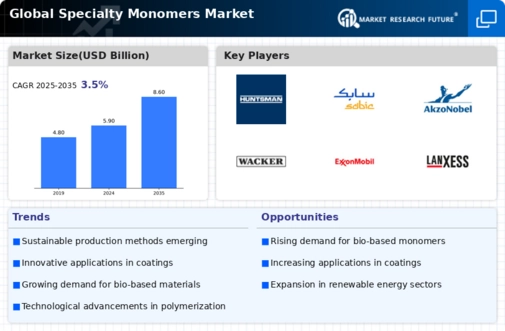Rising Demand for Eco-Friendly Products
The Specialty Monomers Market is experiencing a notable shift towards eco-friendly products, driven by increasing consumer awareness regarding environmental sustainability. This trend is reflected in the growing demand for bio-based monomers, which are derived from renewable resources. As industries strive to reduce their carbon footprint, the adoption of sustainable practices is becoming paramount. Reports indicate that the market for bio-based specialty monomers is projected to grow at a compound annual growth rate (CAGR) of approximately 8% over the next five years. This shift not only aligns with regulatory pressures but also caters to a consumer base that is increasingly prioritizing sustainability in their purchasing decisions. Consequently, manufacturers in the Specialty Monomers Market are investing in research and development to innovate and produce more environmentally friendly monomers.
Regulatory Support for Specialty Chemicals
Regulatory frameworks are increasingly favoring the Specialty Monomers Market, as governments worldwide implement policies that promote the use of specialty chemicals. These regulations often focus on enhancing product safety and environmental protection, which in turn encourages the development of innovative specialty monomers. For instance, initiatives aimed at reducing volatile organic compounds (VOCs) in industrial applications are prompting manufacturers to explore alternative monomer formulations. This regulatory support not only fosters innovation but also creates a more favorable market environment for specialty monomers. As a result, companies that align their product offerings with these regulations are likely to experience enhanced market opportunities. The Specialty Monomers Market stands to benefit from this trend, as compliance with evolving regulations can lead to increased consumer trust and market share.
Growing Investment in Research and Development
Investment in research and development (R&D) is a key driver for the Specialty Monomers Market, as companies strive to innovate and enhance their product offerings. The increasing complexity of consumer demands necessitates the development of new specialty monomers with tailored properties. R&D investments are being directed towards creating monomers that exhibit superior performance characteristics, such as improved thermal stability and chemical resistance. Market analysis indicates that R&D spending in the specialty chemicals sector is projected to grow by approximately 5% annually over the next few years. This focus on innovation not only helps companies differentiate themselves in a competitive landscape but also addresses the evolving needs of various industries. Consequently, the Specialty Monomers Market is likely to see a surge in new product introductions, driven by these strategic investments.
Expanding Applications Across Diverse Industries
The Specialty Monomers Market is witnessing an expansion in applications across various sectors, including automotive, construction, and electronics. This diversification is largely attributed to the unique properties of specialty monomers, which allow for enhanced performance in end products. For example, specialty monomers are increasingly utilized in the formulation of high-performance coatings and adhesives, which are essential in the automotive and construction industries. Market data suggests that the demand for specialty monomers in the coatings sector alone is expected to reach USD 3 billion by 2026. Additionally, the electronics industry is adopting specialty monomers for their use in advanced materials, such as flexible displays and circuit boards. This broadening of applications is likely to drive growth and innovation within the Specialty Monomers Market, as manufacturers seek to meet the evolving needs of diverse sectors.
Technological Innovations in Production Processes
Technological advancements are playing a crucial role in shaping the Specialty Monomers Market. Innovations in production processes, such as the development of more efficient catalytic systems and advanced polymerization techniques, are enhancing the yield and quality of specialty monomers. These advancements not only reduce production costs but also minimize waste, aligning with the industry's sustainability goals. For instance, the introduction of continuous flow reactors has been shown to improve reaction efficiency significantly. Furthermore, the integration of automation and digital technologies in manufacturing processes is expected to streamline operations, thereby increasing competitiveness. As a result, companies that leverage these technological innovations are likely to gain a substantial market advantage, positioning themselves favorably within the Specialty Monomers Market.


















Leave a Comment